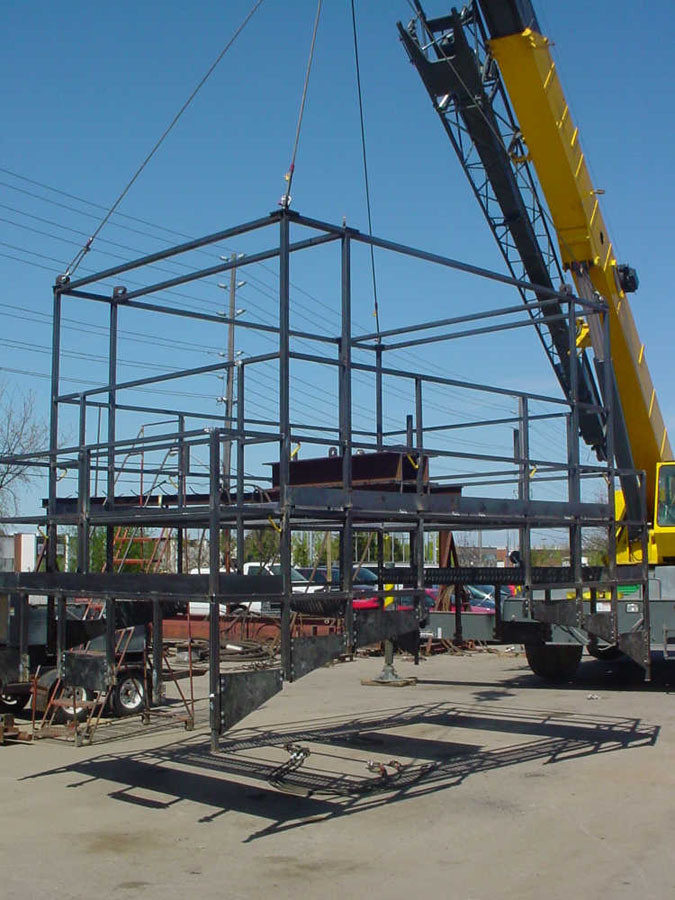Manbasket Use on a Crane

Going Up?
If you own a crane, and especially if you’re in the business of renting it out, you’ve likely had requirements to raise a worker in a manbasket. If so, you should be familiar with section 153 of OHSA’s Regulations for Construction Projects. However, if this section means nothing to you, then you’re not alone. Even though this section was amended nearly ten years ago to allow manbaskets to be used on cranes, we still get requests for information on the applicable rules.
The governing regulations are applied by the Ministry of Labour to both suspended and pin mounted baskets regardless of their construction (usually fiberglass or steel). The reader is referred to those regulations, however, various highlights deserve special mention. With respect to the basket, the following requirements must be met:
- It must be designed by a professional engineer and constructed in accordance with the design drawings.
- The design drawings must be approved by a professional engineer and must detail the construction of the platform, state the maximum live load of the platform, and specify the model and type of crane to be used in conjunction with the platform.
- It must be suspended from or supported by a direct attachment to the boom, and it must have more than one means or suspension or support.
- The rated load capacity must be marked on it.
Similarly, the crane must satisfy various criteria as well:
- The crane must not be loaded in excess of 25% of its maximum rated load. A revised load rating chart prepared by a professional engineer must be affixed to the crane.
- The crane must not hoist material while the platform is being used to lift a worker.
- The crane must have fail safe mechanisms to prevent free fall of the boom or platform and to prevent two-blocking.
- The crane must be structurally inspected annually by a professional engineer or a competent worker designated by a professional engineer using nondestructive testing methods covered by CGSB specifications.
- Any modifications or repairs to the boom shall be made in accordance with the instructions of the manufacturer or a professional engineer.
- The last requirement goes beyond the standard requirements for inspection personnel. Here, the term “competent worker” is defined without ambiguity. As such, this structural inspection cannot be signed off by an operator or by a certified mechanic.
In addition to the above annual inspection, the regulations require that the crane, platform and all attachments be visually inspected by a competent worker before each use. The operator or somebody else familiar with the equipment may perform this inspection.
All inspections are to be recorded in the log book of the crane and the log book must be kept inside the crane along with any design drawings of the basket, the modified load chart, and a copy of the inspection reports for the crane and manbasket.
Clauses 10, 12, and 13 out of section 153 in the regulations discuss requirements for communications, and emergency procedures.
Obviously, good communication between the crane operator and the workers in the basket is paramount. Ideally, radios should be used, however, a system of hand signals should be discussed and agreed upon in case of radio failure.
An emergency rescue procedure needs to be developed by the employer and communicated to all workers involved in writing. The procedure should, at a minimum, address equipment failure, and injury to workers in the basket. Other items specific to the work site should also be considered and included in the procedure as applicable.
Finally, all workers are to receive instruction about the requirements and hazards associated with the manbasket work. How this instruction is performed is left up to the employer; however, a good method is to develop a safe job procedure and hand out a copy of it to employees as a part of their training. A copy should also be given to contractors using personnel baskets on site and their compliance with it should be required.
A safe job procedure should be tailored to fit the requirements or the company and should include items such as:
- communications between the operator, signalman, supervisor, and the workers in the basket
- inspection of equipment before use
- requirements for fall arrest
- responsibilities of the operator, supervisor, and others
- hazards associated with the lift and safety requirements
- communication with the Ministry of Labour
- weather restrictions
- action in case of an accident and/or equipment failure
- installation and operation of the platform
- the need for a pre-lift meeting and for a dry run
- emergency procedures
The safe job procedure should be kept in the crane and on site at all times for reference by workers on site as well as for the Ministry inspector, should he come to visit.




